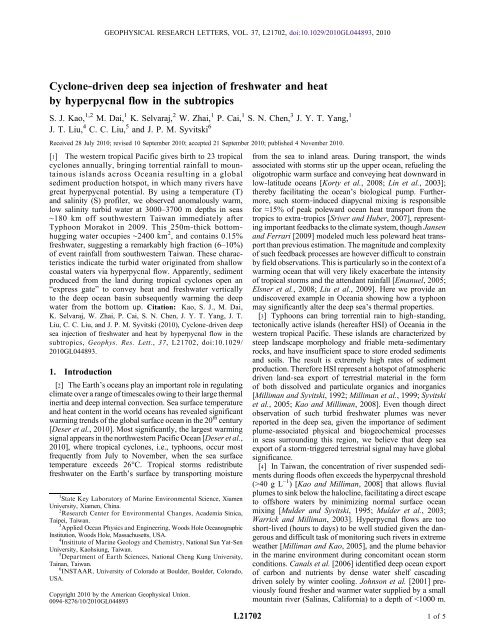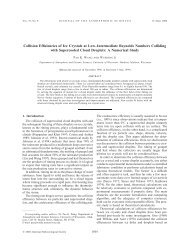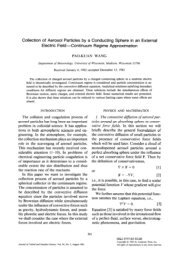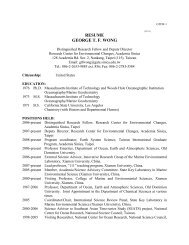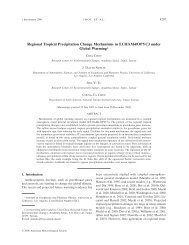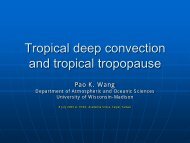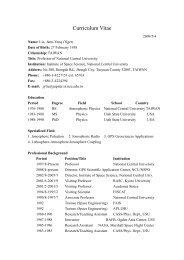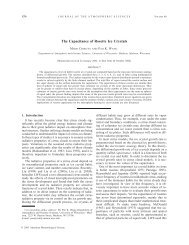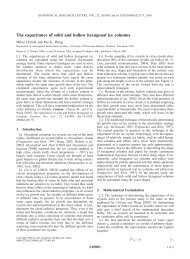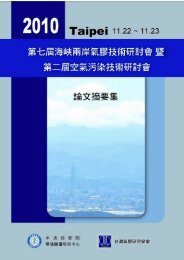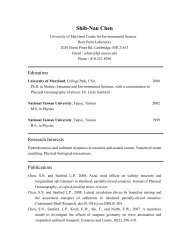PDF file - Academia Sinica
PDF file - Academia Sinica
PDF file - Academia Sinica
Create successful ePaper yourself
Turn your PDF publications into a flip-book with our unique Google optimized e-Paper software.
GEOPHYSICAL RESEARCH LETTERS, VOL. 37, L21702, doi:10.1029/2010GL044893, 2010<br />
Cyclone‐driven deep sea injection of freshwater and heat<br />
by hyperpycnal flow in the subtropics<br />
S. J. Kao, 1,2 M. Dai, 1 K. Selvaraj, 2 W. Zhai, 1 P. Cai, 1 S. N. Chen, 3 J. Y. T. Yang, 1<br />
J. T. Liu, 4 C. C. Liu, 5 and J. P. M. Syvitski 6<br />
Received 28 July 2010; revised 10 September 2010; accepted 21 September 2010; published 4 November 2010.<br />
[1] The western tropical Pacific gives birth to 23 tropical<br />
cyclones annually, bringing torrential rainfall to mountainous<br />
islands across Oceania resulting in a global<br />
sediment production hotspot, in which many rivers have<br />
great hyperpycnal potential. By using a temperature (T)<br />
and salinity (S) pro<strong>file</strong>r, we observed anomalously warm,<br />
low salinity turbid water at 3000–3700 m depths in seas<br />
∼180 km off southwestern Taiwan immediately after<br />
Typhoon Morakot in 2009. This 250m‐thick bottomhugging<br />
water occupies ∼2400 km 2 , and contains 0.15%<br />
freshwater, suggesting a remarkably high fraction (6–10%)<br />
of event rainfall from southwestern Taiwan. These characteristics<br />
indicate the turbid water originated from shallow<br />
coastal waters via hyperpycnal flow. Apparently, sediment<br />
produced from the land during tropical cyclones open an<br />
“express gate” to convey heat and freshwater vertically<br />
to the deep ocean basin subsequently warming the deep<br />
water from the bottom up. Citation: Kao,S.J.,M.Dai,<br />
K. Selvaraj, W. Zhai, P. Cai, S. N. Chen, J. Y. T. Yang, J. T.<br />
Liu, C. C. Liu, and J. P. M. Syvitski (2010), Cyclone‐driven deep<br />
sea injection of freshwater and heat by hyperpycnal flow in the<br />
subtropics, Geophys. Res. Lett., 37, L21702, doi:10.1029/<br />
2010GL044893.<br />
1. Introduction<br />
[2] The Earth’s oceans play an important role in regulating<br />
climate over a range of timescales owing to their large thermal<br />
inertia and deep internal convection. Sea surface temperature<br />
and heat content in the world oceans has revealed significant<br />
warming trends of the global surface ocean in the 20 th century<br />
[Deser et al., 2010]. Most significantly, the largest warming<br />
signal appears in the northwestern Pacific Ocean [Deser et al.,<br />
2010], where tropical cyclones, i.e., typhoons, occur most<br />
frequently from July to November, when the sea surface<br />
temperature exceeds 26°C. Tropical storms redistribute<br />
freshwater on the Earth’s surface by transporting moisture<br />
1 State Key Laboratory of Marine Environmental Science, Xiamen<br />
University, Xiamen, China.<br />
2 Research Center for Environmental Changes, <strong>Academia</strong> <strong>Sinica</strong>,<br />
Taipei, Taiwan.<br />
3 Applied Ocean Physics and Engineering, Woods Hole Oceanographic<br />
Institution, Woods Hole, Massachusetts, USA.<br />
4 Insititute of Marine Geology and Chemistry, National Sun Yat‐Sen<br />
University, Kaohsiung, Taiwan.<br />
5 Department of Earth Sciences, National Cheng Kung University,<br />
Tainan, Taiwan.<br />
6 INSTAAR, University of Colorado at Boulder, Boulder, Colorado,<br />
USA.<br />
Copyright 2010 by the American Geophysical Union.<br />
0094‐8276/10/2010GL044893<br />
L21702<br />
from the sea to inland areas. During transport, the winds<br />
associated with storms stir up the upper ocean, refueling the<br />
oligotrophic warm surface and conveying heat downward in<br />
low‐latitude oceans [Korty et al., 2008; Lin et al., 2003];<br />
thereby facilitating the ocean’s biological pump. Furthermore,<br />
such storm‐induced diapycnal mixing is responsible<br />
for ≈15% of peak poleward ocean heat transport from the<br />
tropics to extra‐tropics [Sriver and Huber, 2007], representing<br />
important feedbacks to the climate system, though Jansen<br />
and Ferrari [2009] modeled much less poleward heat transport<br />
than previous estimation. The magnitude and complexity<br />
of such feedback processes are however difficult to constrain<br />
by field observations. This is particularly so in the context of a<br />
warming ocean that will very likely exacerbate the intensity<br />
of tropical storms and the attendant rainfall [Emanuel, 2005;<br />
Elsner et al., 2008; Liu et al., 2009]. Here we provide an<br />
undiscovered example in Oceania showing how a typhoon<br />
may significantly alter the deep sea’s thermal properties.<br />
[3] Typhoons can bring torrential rain to high‐standing,<br />
tectonically active islands (hereafter HSI) of Oceania in the<br />
western tropical Pacific. These islands are characterized by<br />
steep landscape morphology and friable meta‐sedimentary<br />
rocks, and have insufficient space to store eroded sediments<br />
and soils. The result is extremely high rates of sediment<br />
production. Therefore HSI represent a hotspot of atmospheric<br />
driven land‐sea export of terrestrial material in the form<br />
of both dissolved and particulate organics and inorganics<br />
[Milliman and Syvitski, 1992; Milliman et al., 1999; Syvitski<br />
et al., 2005; Kao and Milliman, 2008]. Even though direct<br />
observation of such turbid freshwater plumes was never<br />
reported in the deep sea, given the importance of sediment<br />
plume‐associated physical and biogeochemical processes<br />
in seas surrounding this region, we believe that deep sea<br />
export of a storm‐triggered terrestrial signal may have global<br />
significance.<br />
[4] In Taiwan, the concentration of river suspended sediments<br />
during floods often exceeds the hyperpycnal threshold<br />
(>40 g L −1 )[Kao and Milliman, 2008] that allows fluvial<br />
plumes to sink below the halocline, facilitating a direct escape<br />
to offshore waters by minimizing normal surface ocean<br />
mixing [Mulder and Syvitski, 1995; Mulder et al., 2003;<br />
Warrick and Milliman, 2003]. Hyperpycnal flows are too<br />
short‐lived (hours to days) to be well studied given the dangerous<br />
and difficult task of monitoring such rivers in extreme<br />
weather [Milliman and Kao, 2005], and the plume behavior<br />
in the marine environment during concomitant ocean storm<br />
conditions. Canals et al. [2006] identified deep ocean export<br />
of carbon and nutrients by dense water shelf cascading<br />
driven solely by winter cooling. Johnson et al. [2001] previously<br />
found fresher and warmer water supplied by a small<br />
mountain river (Salinas, California) to a depth of
L21702<br />
KAO ET AL.: HYPERPYCNAL PLUME IN DEEP SEA<br />
L21702<br />
Figure 1. (a) Satellite image acquired on 13 August by FORMOSAT II with bathymetric contours superimposed. (b) Map<br />
showing southern Taiwan, the Gaoping River, the Gaoping Canyon (black dotted arrow), Manila Trench and three CTD<br />
stations of this study: E401 (black square), E402 (red square) and S608 (red triangle). A rectangular area is assumed for<br />
freshwater volume estimates (see text for details). Undersea cables had broken in sequence as marked by time on 12 August.<br />
(c) Depth pro<strong>file</strong>s of salinity (S), temperature (T) and density (s ) at stations E401 (black) and E402 (red). Black and red<br />
arrows define the upper boundaries of turbidity water mass used for average salinity estimation. (d) The T‐S diagram from<br />
this study combined with the statistical mean T‐S pro<strong>file</strong> of the South China Sea (SCS, purple). Note that the observed T‐S<br />
pro<strong>file</strong>s merge with the SCS curve when s 0 is greater than 25.0; however, in the deep sea they are inverted. Inset diagram is<br />
an enlarged view of inverted portion of the T‐S pro<strong>file</strong> (T = 2.00–2.25°C and S = 34.55–34.65 at ∼2900 m water depth)<br />
collected at station S608 located around 100 km away from the main axis of Gaoping Canyon.<br />
To date, to our knowledge there are no qualitative and<br />
quantitative observations in Oceania regarding the impact of<br />
tropical storms on deep sea characteristics. Here we present<br />
for the first time a rapid injection of cyclone‐induced<br />
freshwater into the deep sea basin (3000–3700 m depths) in a<br />
subtropical region.<br />
2. Typhoon Morakot and Data Acquisition<br />
[5] Typhoon Morakot, a category 2 tropical storm with a<br />
maximum wind speed of 40 m s −1 , invaded Taiwan August<br />
7–9, 2009. The 3‐day accumulated rainfall during the event<br />
exceeded 2000 mm at many river monitoring stations in<br />
southwestern Taiwan. The total rainfall even surpassed the<br />
previous record of 1736 mm set by Typhoon Herb in 1996.<br />
Typhoon Morakot resulted in a number of deadly mudslides<br />
in the mountains, leading to 618 deaths, 67 missing and a<br />
property loss of roughly $3.3 billion US dollars, which was<br />
the most severe natural disaster in Southern Taiwan caused<br />
by a typhoon during the last 50 years. Hong et al. [2010]<br />
attributed such unexpectedly high rainfall to the topographic<br />
lifting effect, a typical meteorological feature of the<br />
HSI in Oceania.<br />
[6] Satellite imagery reveals that Morakot activated a total<br />
rainfall‐triggered landslide area of 152 km 2 in Gaoping<br />
watershed (3250 km 2 , erstwhile Kaoping). After 4 days of the<br />
peak river discharge (August 8 midnight) in Gaoping River<br />
(Figure 1a), FORMOSAT II satellite with a 10 m pixel resolution<br />
captured a clear image of a suspended sediment plume<br />
2of5
L21702<br />
KAO ET AL.: HYPERPYCNAL PLUME IN DEEP SEA<br />
L21702<br />
∼10 km along the Gaoping Canyon off southwestern Taiwan<br />
(Figure 1a). The downstream freeway bridge was washed<br />
away during the flood and the gauging station did not record<br />
the peak values of river discharge. To track the transport<br />
pathway of typhoon Morakot‐sourced turbid water mass in<br />
the deep sea, the oceanographic research vessel, R/V Dongfanghong<br />
II, visited three stations (E401, E402 and S608<br />
(Figure 1b)) on 14th–15th August. We used a conductivitytemperature‐depth<br />
(CTD) probe and rosette sampling system<br />
to pro<strong>file</strong> water properties (Seabird CTD‐rosette SBE‐911).<br />
We retrieved high resolution (0.5‐m interval) CTD pro<strong>file</strong>s to<br />
water depths approaching 50 m above the sea floor at stations<br />
E401 and E402. Figure 1c shows the temperature (T), density<br />
(s ) and salinity pro<strong>file</strong>s of stations E401 and E402. In contrast<br />
to almost all previous deep sea CTD pro<strong>file</strong>s, our T and<br />
S pro<strong>file</strong>s show a distinct T increase with concomitant S<br />
decrease at their bottom depths (Figure 1c). The measured<br />
suspended solid concentrations at station E401 at 2500 m<br />
and 2950 m depths were 28.8 mg L −1 and 201.5 mg L −1 ,<br />
respectively, which are large enough to compensate the T‐S<br />
derived density deficit (0.028 and 0.201 mg cm −3 ) at these<br />
stations to keep the water mass stable.<br />
[7] Since the stations E401 and E402 are located 80 km<br />
apart (Figure 1b), the T‐S reversals observed between them<br />
provide evidence that the unusual bottom‐hugging plume<br />
may occupy a wide geographical area. The greater salinity<br />
decrease appeared at the furthest offshore station E402. This<br />
might reflect either the time history of the hyperpycnal<br />
plume or that the plume might have moved farther south. At<br />
station S608, the CTD rosette were lowered to 151 m above<br />
the sea floor (bottom depth: 3071 m) and T‐S reversal was<br />
still remarkably identifiable at the deepest part of the pro<strong>file</strong><br />
(small panel in Figure 1d). The T‐S inversions observed at<br />
all three stations help us to constrain the minimum volume<br />
of the turbid water mass transported into the deep sea during<br />
typhoon Morakot.<br />
3. Hyperpycnal Plume Source<br />
[8] Theory on the development of a hyperpycnal plume<br />
[Mulder and Syvitski, 1995; Mulder et al., 2003] reveals that<br />
the ambient seawater would be entrained into the flow to<br />
increase S and reduce T. Accordingly, the T‐S feature of<br />
plume water should be skewed toward the typical T‐S characteristics<br />
of the South China Sea (SCS) (Figure 1d) water<br />
mass during travel. Interestingly, the T‐S features of turbid<br />
water mass at stations E401 and E402 are identical and can be<br />
differentiated from that of the deep SCS water. The salinity<br />
value at the bottom of E402 (blue circle in Figure 1c) is<br />
significantly lower than the observed salinity throughout the<br />
water column, except shallow depth of 0.012–0.4 to support a<br />
self‐sustained hyperpycnal flow, conditions that are met for<br />
hyperpycnal flow along the Gaoping Canyon [Liu et al.,<br />
2002].<br />
[11] Serial undersea cable breaks (Figure 1b) were<br />
recorded along the Gaoping Canyon on 12th August. Eight<br />
damaged sites (6 recorded the timings) along the canyon axis<br />
are related to transport emanating from the Gaoping River.<br />
Given the inverse density along with highly turbid waters<br />
observed after breaking events, we hypothesize that the<br />
damage of undersea cable was related to the momentum<br />
impact of seafloor erosion by hyperpycnal flows. Though the<br />
triggering mechanism differs from previous event in the<br />
same area caused by turbidity current associated with submarine<br />
landslide induced by earthquake Hengchun (21.9°N,<br />
120.6° E, M = 7.2 on 26 December 2006) [Hsu et al., 2008],<br />
the hyperpycnal plume shows a similar moving velocity in<br />
the lower canyon (∼30 km/hr).<br />
5. Quantification of the Freshwater Volume<br />
[12] As mentioned earlier, when the turbid freshwater<br />
encountered coastal seawater, significant seawater entrainment<br />
happened as the flow plunged and moved offshore in a<br />
form of hypepycnal underflow [e.g., Mulder et al., 1998].<br />
Extrapolation of the T‐S diagram (pink dashed arrow in<br />
Figure 1d) gives a high source water salinity of around 29 psu.<br />
Since the river mouth gauging station in Gaoping had been<br />
washed away during the flood, we don’t have the critical<br />
ð2Þ<br />
3of5
L21702<br />
KAO ET AL.: HYPERPYCNAL PLUME IN DEEP SEA<br />
L21702<br />
parameters such as river flow velocity and sediment concentration<br />
data to give better estimation or uncertainty of fluid<br />
entrainment at the initial stage in the coastal zone. However,<br />
based on modeling work by Mulder et al. [1998], entrainment<br />
process is most active within a few kilometer of the plunging<br />
point where the flow attains a supercritical condition (i.e.,<br />
entrainment coefficient increases with Froude number, according<br />
to Parker et al. [1986]). The high temperature and salinity<br />
of source water is likely a result of high entrainment rate near<br />
the river mouth, in combination with active wind‐/waveinduced<br />
mixing due to rough sea state during the event.<br />
[13] By the difference in salinity between ambient seawater<br />
(S ASW ) and the turbid water mass (S TWM ), we estimate<br />
the freshwater fraction (V f ) in the total volume of the<br />
turbid water mass (V) as<br />
V f ¼ VS ð ASW S TWM Þ=S ASW ;<br />
V f ¼ V34:602 ð 34:549Þ=34:602:<br />
The average salinity of the turbid water mass was obtained<br />
by averaging salinity values between depths of 2470 and<br />
2922 m (452‐m thick) at station E401 and between 3350<br />
and 3610 m (260‐m thick) at station E402. We obtained<br />
average salinities of 34.545 and 34.557 respectively for the<br />
turbidity water columns at station E401 and E402. The<br />
thickness‐weighted average salinity for these two columns<br />
(34.549) is also used as the average salinity for the turbid<br />
water mass. This is a conservative estimate since a sharper<br />
and larger salinity decrease might exist while approaching<br />
the bottom, as observed at offshore station E402. The<br />
salinity of ambient seawater of 34.602 was derived from<br />
typical South China Sea (SCS) water at depths of 3000 to<br />
3700 m. The resulting freshwater fraction was thus 0.15%.<br />
The uncertainty of this value depends on the representativeness<br />
of two observed salinity pro<strong>file</strong>s for the plume water.<br />
Riskier and more difficult in‐situ observations and full‐scale<br />
modeling effort are needed to obtain in‐depth understanding<br />
about the behavior and magnitude of hyperpycnal plumes.<br />
[14] For mass volume, we assumed a 30‐km width<br />
(Figure 1b) for the turbid water mass and a minimum thickness<br />
of 250 m, which is smaller than the column thickness<br />
used for average salinity estimate. Taking into account the<br />
80 km distance between stations E401 and E402, we calculated<br />
that the total volume (V = 80 km × 30 km × 250 m)<br />
of the turbid water mass was 600 km 3 , yielding an estimate<br />
for V f of 0.9 km 3 (freshwater amount), which represents<br />
∼10% of total rainfall (2777 mm) precipitated in the<br />
Gaoping watershed (3250 km 2 ) during typhoon Morakot<br />
(9.0 km 3 ). If we take nearby rivers into consideration, the<br />
total watershed area will be ∼5700 km 2 . This conservative<br />
estimate still occupies a fraction of ∼6% of event rainfall.<br />
Such a high proportion of freshwater entrainment into the<br />
deep sea via hyperpycnal plume is previously unknown. The<br />
sediment particles in this deep water mass would settle out<br />
eventually, thus leaving a buoyantly unstable water mass,<br />
altering convective mixing in the quiescent deep sea.<br />
[15] It is interesting to point out that the heat carried by<br />
the hyperpycnal plume derived mostly from the warm<br />
shallow coastal waters (as indicated in Figure 1d) rather than<br />
the freshwater itself during plunging. Thus, by extrapolating<br />
the mixing line to the freshwater end with salinity of 0, we<br />
will obtain an unreasonably high temperature (180°C) for<br />
ð3Þ<br />
freshwater. This indicates that Hyperpycnal Rivers in the<br />
tropics and subtropics may carry extra heat from the surface<br />
thermocline to the deep basin.<br />
[16] Based on 3.5‐kHz echogram pro<strong>file</strong>s, Damuth [1979]<br />
reported a 25,000 km 2 field of migrating sediment waves in<br />
this study area extending as far as 450 km away to 17°N<br />
(area enclosed by red dashed line in Figure 1b). He noted<br />
that the sediment wave developed adjacent to the Manila<br />
Trench, the major turbidity current pathway and depocenter,<br />
suggesting the waves were created by the upper part of the<br />
turbidity flows that were thick enough to escape the confines<br />
of the trench and thus spread laterally outward (westward)<br />
across the left trench wall with gentle slope. This sediment<br />
wave is supportive of frequent occurrence of gravityinduced<br />
downslope flows to regional extent, though the<br />
trigger may be both earthquake and cyclone.<br />
[17] Based on our recent integrated project conducted in<br />
Taiwan (FATES: Fate of Terrestrial Substances), downslope<br />
transport of warm water with ∼2°C anomaly to 600 m was<br />
commonly observed during the cyclone invasion period (2–<br />
7 days) either due to high turbidity freshwater discharge<br />
(unpublished data) or due to strong wave resuspension in<br />
shallow coastal zones as reported by Johnson et al. [2001].<br />
How deep/far those warm waters may reach is still not<br />
known, yet a 2°C anomaly is believed to be adequate to alter<br />
the thermocline. Since the frequency of cyclone occurrence<br />
is much higher than that of earthquake‐induced submarine<br />
landslides, we suggest that the large area of sand waves in<br />
the northern South China Sea proposed by Damuth [1979]<br />
was more likely triggered by cyclones.<br />
6. Implication and Conclusion<br />
[18] Our study off southwestern Taiwan shows that storminduced<br />
hyperpycnal plumes can penetrate into the deep sea<br />
to depths >3700 m. Given the geographic location and<br />
geomorphic river‐shelf‐slope continuum, we argue that<br />
high‐standing islands may transport event rainfall, heat and<br />
terrestrial material rapidly into the deep West Pacific Ocean.<br />
It is difficult to extrapolate the effect of a single event<br />
(Morakot) to Oceania, due to insufficient systematic observation.<br />
However, Parsons et al. [2001] demonstrated that<br />
even a low sediment concentration of 5 g L −1 can create a<br />
hyperpycnal plume. Their results allow us to conceptually<br />
generalize our case to Oceania where the small mountain<br />
rivers mostly go hyperpycnally during typhoons. In contrast<br />
to well‐known top‐down mixing in surface ocean, the turbid<br />
water mass physically intrudes into the bottom and might<br />
enhance deepwater ventilation by pushing up the deep water<br />
column, thereby facilitating large‐scale bottom‐up advection.<br />
Due to frequent typhoon events in this area, this mixing<br />
will certainly have a regional impact although the penetration<br />
depth is dependent on sediment concentration driven by<br />
rainfall intensity. An increase in the frequency of stronger<br />
cyclones in the general context of climate change might<br />
thus result in the injection of ever larger volumes of fresh<br />
warm water directly into the deep ocean along with heat,<br />
inorganic particles and terrestrial organic carbon. Thus, such<br />
atmospherically‐driven deep sea injection may represent an<br />
important but hitherto unexplored process in global ocean<br />
dynamics and climate feedbacks. Since the typhoon disturbance<br />
on the deep sea characteristics in the Oceania region<br />
4of5
L21702<br />
KAO ET AL.: HYPERPYCNAL PLUME IN DEEP SEA<br />
L21702<br />
was poorly studied, we recommend more observational and<br />
theoretical research on this under‐observed phenomenon.<br />
[19] Acknowledgments. Funded by China (973 Program,<br />
2009CB421200 and the program of Introducing Talents of Discipline to<br />
Universities, B07034) and Taiwan (NSC 98‐2116‐M‐001‐005; <strong>Academia</strong><br />
<strong>Sinica</strong> Thematic Program AFOBi). We thank Y. Li (Ocean University of<br />
China), Z. Sun (Xiamen University) and the captain and crew of the<br />
R/V Donfanghong II for their assistance during the sampling cruise. We<br />
are thankful to J. D. Milliman and S. Jan (IO‐National Taiwan University)<br />
for comments. Two anonymous reviewers are thanked for their helpful<br />
comments on the original manuscript. We appreciate Chunghwa Telecom‐<br />
Toucheng Undersea Cable Station (Section Chief Guan, R. D.) for providing<br />
valuable information.<br />
References<br />
Canals, M., P. Puig, X. D. de Madron, S. Heussner, A. Palanques, and<br />
J. Fabres (2006), Flushing submarine canyons, Nature, 444, 354–357,<br />
doi:10.1038/nature05271.<br />
Damuth, J. E. (1979), Migrating sediment waves created by turbidity currents<br />
in the northern South China Basin, Geology, 7, 520–523,<br />
doi:10.1130/0091-7613(1979)72.0.CO;2.<br />
Deser, C., A. S. Phillips, and M. A. Alexander (2010), Twentieth century<br />
tropical sea surface temperature trends revisited, Geophys. Res. Lett.,<br />
37, L10701, doi:10.1029/2010GL043321.<br />
Elsner, J. B., J. P. Kossin, and T. H. Jagger (2008), The increasing intensity<br />
of the strongest tropical cyclones, Nature, 455, 92–95, doi:10.1038/<br />
nature07234.<br />
Emanuel, K. (2005), Increasing destructiveness of tropical cyclones over<br />
the past 30 years, Nature, 436, 686–688, doi:10.1038/nature03906.<br />
Hong, C. C., M. Y. Lee, H. H. Hsu, and J. L. Kuo (2010), Role of submonthly<br />
disturbance and 40–50 day ISO on the extreme rainfall event<br />
associated with Typhoon Morakot (2009) in southern Taiwan, Geophys.<br />
Res. Lett., 37, L08805, doi:10.1029/2010GL042761.<br />
Hsu, S. K., Y. C. Yeh, C. L. Lo, A. T. S. Lin, and W. B. Doo (2008), Link<br />
between crustal magnetization and earthquakes in Taiwan, Terr. Atmos.<br />
Oceanic Sci., 19, 445–450, doi:10.3319/TAO.2008.19.5.445(T).<br />
Jansen, M., and R. Ferrari (2009), Impact of the latitudinal distribution of<br />
tropical cyclones on ocean heat transport, Geophys. Res. Lett., 36,<br />
L06604, doi:10.1029/2008GL036796.<br />
Johnson, K. S., C. K. Paull, J. P. Barry, and F. P. Chavez (2001), A decadal<br />
record of underflows from a coastal river into the deep sea, Geology, 29,<br />
1019–1022, doi:10.1130/0091-7613(2001)0292.0.<br />
CO;2.<br />
Kao, S. J., and J. D. Milliman (2008), Water and sediment discharges from<br />
small mountainous rivers, Taiwan: The roles of lithology, episodic<br />
events, and human activities, J. Geol., 116, 431–448, doi:10.1086/<br />
590921.<br />
Kao, S. J., F. K. Shiah, C. H. Wang, and K. K. Liu (2006), Efficient trapping<br />
of organic carbon in sediments on the continental margin with high<br />
fluvial sediment input off southwestern Taiwan, Cont. Shelf Res., 26,<br />
2520–2537, doi:10.1016/j.csr.2006.07.030.<br />
Korty, R. L., K. A. Emanuel, and J. R. Scott (2008), Tropical cyclone–<br />
induced upper‐ocean mixing and climate: Application to equable climates,<br />
J. Clim., 21, 638–654, doi:10.1175/2007JCLI1659.1.<br />
Lin, I. I., W. T. Liu, C. C. Wu, J. C. H. Chiang, and C. H. Sui (2003), Satellite<br />
observations of modulation of surface winds by typhoon‐induced<br />
upper ocean cooling, Geophys. Res. Lett., 30(3), 1131, doi:10.1029/<br />
2002GL015674.<br />
Liu, J. T., K. J. Liu, and J. C. Huang (2002), The effect of a submarine<br />
canyon on the river sediment dispersal and inner shelf sediment movements<br />
in southern Taiwan, Mar. Geol., 181, 357–386, doi:10.1016/<br />
S0025-3227(01)00219-5.<br />
Liu, S. C., C. Fu, C. J. Shiu, J. P. Chen, and F. Wu (2009), Temperature<br />
dependence of global precipitation extremes, Geophys. Res. Lett., 36,<br />
L17702, doi:10.1029/2009GL040218.<br />
Milliman, J. D., and S. J. Kao (2005), Hyperpycnal discharge of fluvial sediment<br />
to the ocean: Impact of Super‐Typhoon Herb (1996) on Taiwanese<br />
rivers, J. Geol., 113, 503–516, doi:10.1086/431906.<br />
Milliman, J. D., and J. P. M. Syvitski (1992), Geomorphic tectonic control<br />
of sediment discharge to the ocean: The importance of small mountainous<br />
rivers, J. Geol., 100, 525–544, doi:10.1086/629606.<br />
Milliman, J. D., K. L. Farnsworth, and C. S. Albertin (1999), Flux and fate<br />
of fluvial sediments leaving large islands in the East Indies, J. Sea Res.,<br />
41, 97–107, doi:10.1016/S1385-1101(98)00040-9.<br />
Mulder, T., and J. P. M. Syvitski (1995), Turbidity currents generated at<br />
river mouths during exceptional discharges to the world oceans, J. Geol.,<br />
103, 285–299, doi:10.1086/629747.<br />
Mulder, T., J. P. M. Syvitski, and K. Skene (1998), Modeling of erosion and<br />
deposition by sediment gravity flows generated at river mouths, J. Sediment.<br />
Res., 67, 124–137.<br />
Mulder, T., J. P. M. Syvitski, S. Migeon, J. C. Faugeres, and B. Savoye<br />
(2003), Marine hyperpycnal flows: Initiation, behavior and related deposits.<br />
A review, Mar. Pet. Geol., 20, 861–882, doi:10.1016/j.marpetgeo.<br />
2003.01.003.<br />
Parker, G., Y. Fukushima, and H. M. Pantin (1986), Self‐accelerating turbidity<br />
currents, J. Fluid Mech., 171,145–181, doi:10.1017/S0022112086001404.<br />
Parsons, J. D., J. Bush, and J. P. M. Syvitski (2001), Hyperpycnal plume<br />
formation with small sediment concentrations, Sedimentology, 48,<br />
465–478, doi:10.1046/j.1365-3091.2001.00384.x.<br />
Sriver, R. L., and M. Huber (2007), Observational evidence for an ocean<br />
heat pump induced by tropical cyclones, Nature, 447, 577–580,<br />
doi:10.1038/nature05785.<br />
Syvitski, J. P. M., C. J. Vörösmarty, A. J. Kettner, and P. Green (2005),<br />
Impacts of humans on the flux of terrestrial sediments to the global<br />
coastal ocean, Science, 308, 376–380, doi:10.1126/science.1109454.<br />
Traykovski, P., W. R. Geyer, J. D. Irish, and J. F. Lynch (2000), The role of<br />
wave‐induced density‐driven fluid mud flows for cross‐shelf transport<br />
on the Eel River continental shelf, Cont. Shelf Res., 20, 2113–2140,<br />
doi:10.1016/S0278-4343(00)00071-6.<br />
van Kessel, T., and C. Kranenburg (1996), Gravity current of fluid mud on<br />
sloping bed, J. Hydraul. Eng., 122, 710–717, doi:10.1061/(ASCE)0733-<br />
9429(1996)122:12(710).<br />
Warrick, J. A., and J. D. Milliman (2003), Hyperpycnal sediment discharge<br />
from semiarid southern California rivers: Implications for coastal sediment<br />
budgets, Geology, 31, 781–784, doi:10.1130/G19671.1.<br />
Wright, L. D., and C. T. Friedrichs (2006), Gravity‐driven sediment transport<br />
on continental shelves: A status report, Cont. Shelf Res., 26, 2092–2107,<br />
doi:10.1016/j.csr.2006.07.008.<br />
Wright, L. D., C. T. Friedrichs, S. C. Kim, and M. E. Scully (2001),<br />
Effects of ambient currents and waves on gravity‐driven sediment transport<br />
on continental shelves, Mar. Geol., 175, 25–45, doi:10.1016/S0025-<br />
3227(01)00140-2.<br />
P. Cai, M. Dai, J. Y. T. Yang, and W. Zhai, State Key Laboratory of<br />
Marine Environmental Science, Xiamen University, 422 Siming Nanlu,<br />
Xiamen 361005, China.<br />
S. N. Chen, Applied Ocean Physics and Engineering, Woods Hole<br />
Oceanographic Institution, MS 10, Woods Hole, MA 02543, USA.<br />
S. J. Kao and K. Selvaraj, Research Center for Environmental Changes,<br />
<strong>Academia</strong> <strong>Sinica</strong>, No. 128, Sec. 2 <strong>Academia</strong> Rd., Taipei 115, Taiwan.<br />
(sjkao@gate.sinica.edu.tw)<br />
C. C. Liu, Department of Earth Sciences, National Cheng Kung<br />
University, Tainan 701, Taiwan.<br />
J. T. Liu, Institute of Marine Geology and Chemistry, National Sun<br />
Yat‐Sen University, Kaohsiung 804, Taiwan.<br />
J. P. M. Syvitski, INSTAAR, University of Colorado at Boulder,<br />
Environmental Computation and Imaging Facility, Campus Box 450,<br />
1560 30th St., Boulder, CO 80309‐0450, USA.<br />
5of5


